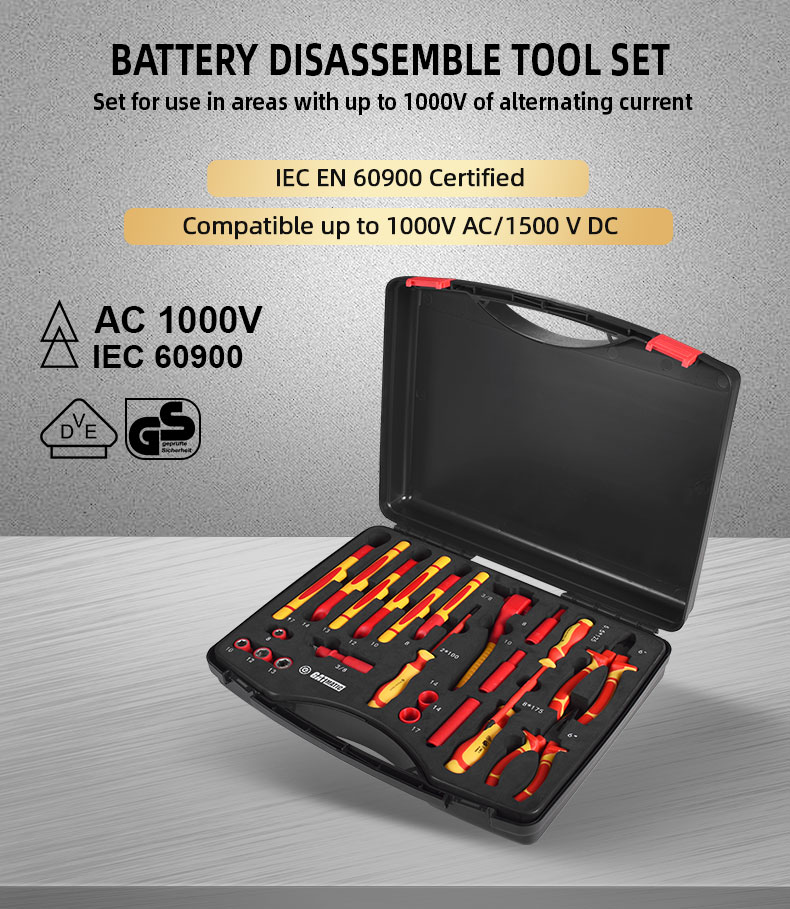What is the difference between VDE-certified tools and non-certified tools?
In industries where electrical work is paramount, safety and reliability are critical concerns. The tools used by electricians and engineers must adhere to high standards to ensure protection against electrical hazards. One of the most recognized standards for tool certification is the VDE (Association for Electrical, Electronic & Information Technologies) certification. This certification guarantees that tools are tested and approved for use in high-voltage environments. In contrast, non-certified tools lack the rigorous testing required to guarantee electrical safety. This essay will explore the differences between VDE-certified tools and non-certified tools, focusing on safety, quality, and cost considerations.
I. What is VDE Certification?
VDE certification is an internationally recognized standard that ensures electrical tools meet stringent safety requirements. VDE, based in Germany, focuses on testing and certifying tools to protect users working with electricity. Tools that receive VDE certification are subject to rigorous testing, including high-voltage insulation, material durability, and performance under stress. VDE-certified tools must meet or exceed standards for protection up to AC 1000V or DC 1500V, making them reliable for high-voltage tasks. This certification provides assurance to users that the tools they are using have undergone extensive testing to ensure safety and reliability in electrical work.
II. Characteristics of VDE-Certified Tools
VDE-certified tools are distinguished by several key characteristics:
- High-Voltage Protection: These tools are rated to withstand high-voltage environments, often up to AC 1000V. This level of protection is critical for electricians and engineers working with live electrical systems, ensuring that the tools provide insulation from potentially dangerous currents.
- Durability and Quality: VDE certification ensures that tools are made from high-quality materials and are built to last. The rigorous testing process includes assessments of the tool’s resistance to mechanical impact, heat, and moisture, all of which can affect performance in demanding environments.
- Ergonomics and Comfort: VDE tools are designed with the user in mind. Given that professionals often use these tools for extended periods, ergonomic design is a priority. Tools are crafted to minimize hand fatigue and maximize comfort.
- Clearly Marked Certification Symbols: All VDE-certified tools carry distinct symbols and markings that indicate their compliance with the certification standards. This visual cue allows users to easily identify which tools are suitable for electrical work.
- Traceability: VDE-certified tools often include serial numbers or other forms of identification, allowing users to trace the tool’s manufacturing and testing history. This adds an additional layer of confidence in the tool’s reliability.
III. Non-Certified Tools Overview
Non-certified tools, by contrast, lack the safety and performance guarantees that come with VDE certification. These tools may be suitable for general use, but their absence of testing for electrical safety makes them less reliable in high-risk environments.
- Absence of VDE Standards: Non-certified tools do not adhere to the stringent requirements set by VDE, meaning there is no guarantee of electrical insulation or protection against high-voltage scenarios.
- Variable Quality: The materials and construction of non-certified tools can vary greatly. Since these tools are not subject to the same testing standards, the durability and overall quality can be inconsistent.
- Limited Safety Testing: Non-certified tools may not undergo the rigorous testing process required to ensure their safety for use in electrical work. This lack of testing poses significant risks when working with live electricity.
- Cost Considerations: Non-certified tools are generally more affordable than VDE-certified tools, but this comes at the expense of safety and reliability. While they may save money upfront, the potential risks in electrical environments make them a less desirable option for professionals.
IV. Key Differences Between VDE-Certified and Non-Certified Tools
The differences between VDE-certified and non-certified tools can be categorized into four main areas:
- Safety Standards: VDE-certified tools offer a high level of safety assurance, particularly in high-voltage situations. Non-certified tools, however, may not provide adequate insulation or protection, increasing the risk of injury or electric shock.
- Testing and Verification: Tools that are VDE-certified undergo rigorous testing to ensure they can withstand electrical currents and other environmental factors. Non-certified tools are not subjected to such tests, leaving their reliability in question.
- Usage: VDE-certified tools are essential for electrical professionals who regularly work with live systems. Non-certified tools may be appropriate for mechanical tasks or non-electrical work, where safety is less of a concern.
- Price and Availability: While non-certified tools are often cheaper and more widely available, the potential long-term risks and consequences in electrical work outweigh the initial cost savings.
V. Applications and Use Cases
VDE-certified tools are primarily used by electricians, electrical engineers, and other professionals who work in high-voltage environments. These tools are designed to offer protection against electric shock, making them essential for those working with live wires or in potentially hazardous conditions. Non-certified tools, on the other hand, are more suitable for general tasks such as mechanical work or DIY projects that do not involve electrical hazards. The lack of guaranteed safety standards makes them unsuitable for electrical work.
VI. Consequences of Using Non-Certified Tools in Electrical Work
The use of non-certified tools in electrical work can have severe consequences. The most immediate risk is electric shock, which can lead to serious injury or death. Non-certified tools are also more likely to fail during critical tasks, leading to equipment damage or accidents. In some cases, the use of non-certified tools in professional settings may violate safety regulations, resulting in legal and financial repercussions.
Conclusion
The difference between VDE-certified tools and non-certified tools boils down to safety, reliability, and cost. While VDE-certified tools may come at a higher price, their extensive testing and compliance with international standards make them indispensable for professionals working with electricity. Non-certified tools, while cheaper, do not offer the same level of protection and can pose significant risks when used in electrical environments. Ultimately, prioritizing safety and reliability over cost is essential for anyone working with electrical systems, and VDE-certified tools provide the peace of mind needed to get the job done safely.
FAQ
1. What does VDE certification mean for tools?
VDE certification means that a tool has been tested and approved according to strict safety standards set by the VDE (Association for Electrical, Electronic & Information Technologies). These standards ensure the tool provides adequate insulation and protection for working in high-voltage environments, typically up to AC 1000V or DC 1500V.
2. Why are VDE-certified tools more expensive than non-certified tools?
VDE-certified tools are more expensive because they undergo rigorous testing and must meet stringent safety standards. This includes testing for electrical insulation, durability, heat resistance, and ergonomic design. The higher cost reflects the enhanced safety, quality, and reliability required for working with electricity.
3. Can I use non-certified tools for electrical work?
It is not recommended to use non-certified tools for electrical work, especially in high-voltage environments. Non-certified tools may not provide sufficient insulation or protection, increasing the risk of electric shock or injury. For electrical tasks, VDE-certified tools should always be used to ensure safety.
4. What are the risks of using non-certified tools in electrical work?
Using non-certified tools in electrical work can lead to serious consequences, such as electric shock, equipment damage, and even death. Non-certified tools may lack proper insulation, fail under high stress, or be made of materials that do not meet safety standards, posing a significant risk to the user.
5. How can I identify if a tool is VDE-certified?
VDE-certified tools will have a clear VDE symbol or marking on them, indicating they have been tested and approved for electrical safety. These tools also often include other details such as voltage ratings and serial numbers to track their manufacturing and testing history.
6. Do VDE-certified tools require special maintenance?
VDE-certified tools do not require special maintenance beyond standard care for any professional tool. However, they should be regularly inspected for signs of wear, especially the insulation, to ensure they remain safe for use in electrical environments.
Describe Your Needs In Detail!
We will carefully evaluate your needs and give professional solutions.



